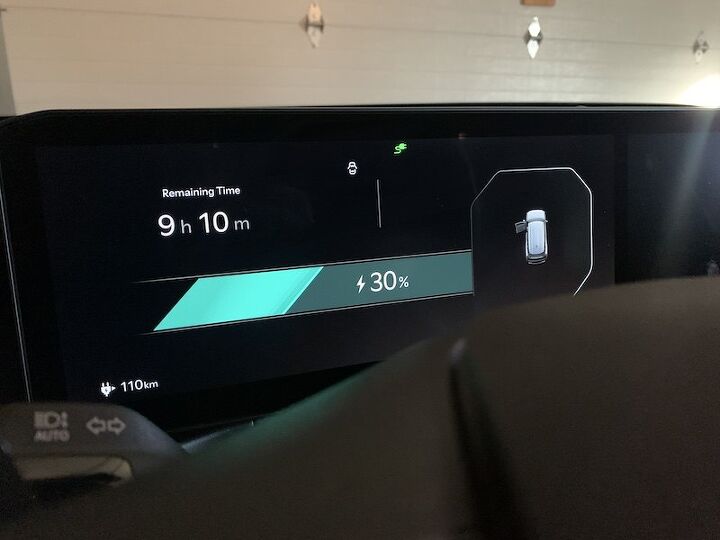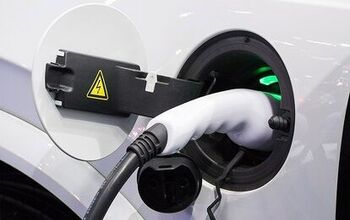Amped Up: Installing an EV Charger at Home

There’s no shortage of debate in this country about electric vehicles – and for good reason. For some, the technology just isn’t quite there yet to fulfil the daily duties they require of their primary vehicle. For others, existing levels of range being offered in the marketplace suits their needs just fine. Other considerations like affordability and performance are as much case-by-case as an individual’s dinner order at a restaurant.
One thing almost everyone can agree on? The appalling state of public charging infrastructure. Faced with broken chargers or a simple lack thereof, your decided to make the leap and install a Level 2 charger in the garage space attached to his home.
It’s a service to you, too, dear reader. Third party studies and anecdotes alike suggest many EV owners carry out up to 80 percent of charging at home, not at the perpetually frustrating public units. With a Level 2 charger at hand, we can better replicate the typical experience of a real-world EV owner and bring you more comprehensive report of whatever electric vehicle is darkening our driveway in a particular week instead of turning the review into a vehicle for kvetching about the state of communal charging stations.
Before diving into the details, we’ll remind anyone who fell asleep in class that the chargers which a provided as standard with most EVs and PHEVs are called Level 1 units and plug into a normal 110V household outlet as if one were plugging in their Samsung television or knackered old Xbox. Level 2 chargers connect to a 220V outlet, like the ones used to power an electric range or clothes dryer. Technically, it’s called a NEMA 14-50 outlet.
This option from a company called Autel was selected based on a $399 price, connectivity features, and – to be blunt – a promise of fast shipping. Called the MaxiCharger AC Lite, it is equipped with the standard J1772 plug which is part and parcel of most EVs today but will soon be making way for the NACS (Tesla) charging plug. I’m not concerned about that development because convenient adapters for making the conversion are small and inexpensive.
Make sure to get a unit which has power cords sufficient for yer needs. This Autel has a 25-foot charging cable while the one that plugs into the wall is nearly 3 feet long. This will help position the charger in a convenient spot – whether that convenience is centred around usage or installation is up to you and your electrician. Speaking of, I paid a certified professional less than $300 to wire up the required outlet and 40A circuit breaker; it probably would have been cheaper if we weren’t fans of rival hockey teams.
Usage was simple as the day is long. After installing a mounting bracket on wall studs and hanging the charger, all that was required for set up was to simply plug the thing into our new 220A outlet. A couple of blinking lights confirmed the charger was working properly, and a couple more indicated power was flowing once connected to the charging port of a Kia EV9. Dashboard readouts on the blue Kia suggested it was hoovering up electrons to the tune of roughly 7.0kW, a figure which jived with information provided through the Autel app.
And, no, Luddites – you don’t have to install the app on a smart device in order to make the charger work. However, this writer enjoys the ability to start and stop charging remotely, to say nothing of the detailed reports of charging sessions he can export to a nerdy Excel spreadsheet. For example, my charging session of February 11th shows the EV9 consumed 84kWh over 12 hours (about 8pm to 8am), working out to approximately $9.25 USD of electricity at the kWh cost offered where I reside and today’s exchange rate.
Regular unleaded costs about $5.00 per US gallon in my neck of the woods (also at today’s exchange rate) and adding 84kWh to an EV9 is estimated to add about 200 miles of range. This means I’d have to rock a vehicle getting better than 100 mpg in order to best this performance, at least in terms of dollars and cents. Of course, it doesn’t take 12 hours to fill up at a gas station but consider the following notion: if this writer had the option of installing a gas pump from which to refuel his Challenger whilst he slept every night and then get 100 mpg, he’d be furiously happy. I expect the Autel to pay for itself in jig time.
EVs aren’t right for every driver in every application; that’s an established notion and an argument for a different time. But for those who have the space and whom an EV or PHEV makes sense – financially and practically – installing a Level 2 charger like the one we selected is an absolute no-brainer.
[Images: Author]
Become a TTAC insider. Get the latest news, features, TTAC takes, and everything else that gets to the truth about cars first by subscribing to our newsletter.

Matthew buys, sells, fixes, & races cars. As a human index of auto & auction knowledge, he is fond of making money and offering loud opinions.
More by Matthew Guy
Latest Car Reviews
Read moreLatest Product Reviews
Read moreRecent Comments
- Bd2 Lexus is just a higher trim package Toyota. ^^
- Tassos ONLY consider CIvics or Corollas, in their segment. NO DAMNED Hyundais, Kias, Nissans or esp Mitsus. Not even a Pretend-BMW Mazda. They may look cute but they SUCK.I always recommend Corollas to friends of mine who are not auto enthusiasts, even tho I never owed one, and owned a Civic Hatch 5 speed 1992 for 25 years. MANY follow my advice and are VERY happy. ALmost all are women.friends who believe they are auto enthusiasts would not listen to me anyway, and would never buy a Toyota. They are damned fools, on both counts.
- Tassos since Oct 2016 I drive a 2007 E320 Bluetec and since April 2017 also a 2008 E320 Bluetec.Now I am in my summer palace deep in the Eurozone until end October and drive the 2008.Changing the considerable oils (10 quarts synthetic) twice cost me 80 and 70 euros. Same changes in the US on the 2007 cost me $219 at the dealers and $120 at Firestone.Changing the air filter cost 30 Euros, with labor, and there are two such filters (engine and cabin), and changing the fuel filter only 50 euros, while in the US they asked for... $400. You can safely bet I declined and told them what to do with their gold-plated filter. And when I changed it in Europe, I looked at the old one and it was clean as a whistle.A set of Continentals tires, installed etc, 300 EurosI can't remember anything else for the 2008. For the 2007, a brand new set of manual rec'd tires at Discount Tire with free rotations for life used up the $500 allowance the dealer gave me when I bought it (tires only had 5000 miles left on them then)So, as you can see, I spent less than even if I owned a Lexus instead, and probably less than all these poor devils here that brag about their alleged low cost Datsun-Mitsus and Hyundai-Kias.And that's THETRUTHABOUTCARS. My Cars,
- NJRide These are the Q1 Luxury division salesAudi 44,226Acura 30,373BMW 84,475Genesis 14,777Mercedes 66,000Lexus 78,471Infiniti 13,904Volvo 30,000*Tesla (maybe not luxury but relevant): 125,000?Lincoln 24,894Cadillac 35,451So Cadillac is now stuck as a second-tier player with names like Volvo. Even German 3rd wheel Audi is outselling them. Where to gain sales?Surprisingly a decline of Tesla could boost Cadillac EVs. Tesla sort of is now in the old Buick-Mercury upper middle of the market. If lets say the market stays the same, but another 15-20% leave Tesla I could see some going for a Caddy EV or hybrid, but is the division ready to meet them?In terms of the mainstream luxury brands, Lexus is probably a better benchmark than BMW. Lexus is basically doing a modern interpretation of what Cadillac/upscale Olds/Buick used to completely dominate. But Lexus' only downfall is the lack of emotion, something Cadillac at least used to be good at. The Escalade still has far more styling and brand ID than most of Lexus. So match Lexus' quality but out-do them on comfort and styling. Yes a lot of Lexus buyers may be Toyota or import loyal but there are a lot who are former GM buyers who would "come home" for a better product.In fact, that by and large is the Big 3's problem. In the 80s and 90s they would try to win back "import intenders" and this at least slowed the market share erosion. I feel like around 2000 they gave this up and resorted to a ton of gimmicks before the bankruptcies. So they have dropped from 66% to 37% of the market in a quarter century. Sure they have scaled down their presence and for the last 14 years preserved profit. But in the largest, most prosperous market in the world they are not leading. I mean who would think the Koreans could take almost 10% of the market? But they did because they built and structured products people wanted. (I also think the excess reliance on overseas assembly by the Big 3 hurts them vs more import brands building in US). But the domestics should really be at 60% of their home market and the fact that they are not speaks volumes. Cadillac should not be losing 2-1 to Lexus and BMW.
- Tassos Not my favorite Eldorados. Too much cowbell (fins), the gauges look poor for such an expensive car, the interior has too many shiny bits but does not scream "flagship luxury", and the white on red leather or whatever is rather loud for this car, while it might work in a Corvette. But do not despair, a couple more years and the exterior designs (at least) will sober up, the cowbells will be more discreet and the long, low and wide 60s designs are not far away. If only the interiors would be fit for the price point, and especially a few acres of real wood that also looked real.






































Comments
Join the conversation
Do I have this right…$0.11 per kWH? Where I live (Massachusetts) we pay $0.44/kWH, and it’s been as high as $0.64 in the past 24 months due to seasonal adjustments. If you get the equivalent of 100 mpg at $5.00/gallon, I’d get 25 mpg equivalent because my electricity is 4x more expensive.
Except I get 30 mpg (actual daily driving mileage over 2 weeks.) And regular is $3.50 so the gap is even bigger.
Maybe if I were commuting 20 miles into Boston every day, stuck in stop-and-go traffic for 90 minutes, an EV would make sense. 40 miles round trip to and from the garage charger, and EV mileage probably isn’t much affected by stop-and-go.
Thank you, though, for sharing your experience. Sharing real numbers is illuminating.
I bought this EVSE - it charges fine, but none of the Smart features work through the APP. No notifications, no charging history, no remote start / stop control, WiFi works, but only when in Bluetooth range. I installed in late Feb and Autel has said this is a software issue - still not resolved - they won't replace the unit or refund, so for now I just have to wait for an update. Just curious to see if your App and Smart Features are still working and whether your opinion has changed.
What's extra annoying is Amazon is censoring reviews on this product and won't allow negative posts. Within the Autel app there is a bug comment section and hundreds of people are complaining about similar issues.
Based on my experience I would not recommend Autel EVSEs - they are not Smart chargers, just vaporware - fake it till you make it!